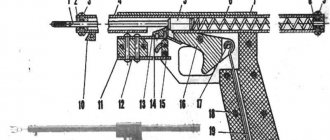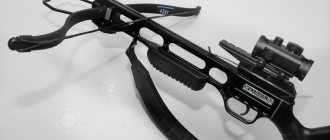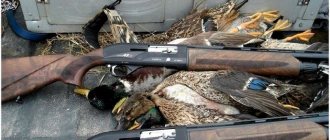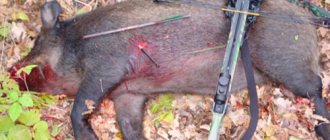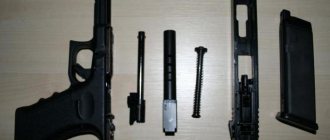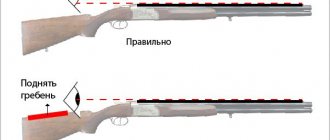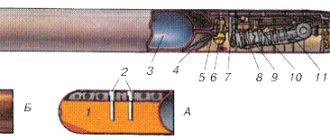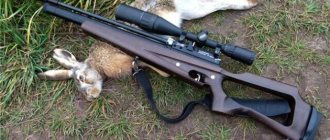- March 25, 2020
- Weapons and ammunition
- Makarova Kristina
Many fishermen prefer not to sit with a fishing rod on the shore, but to hunt underwater. It brings much more pleasure and thrill. At least you can hide underwater, hide and see the predator in all its glory. And in order for hunting underwater to bring extremely positive emotions, you need to purchase a good speargun for spearfishing, and also learn how to use it correctly, so that later during spearfishing you will not have questions such as loading the gun and much more. And also in order not to get hurt yourself and not to harm others.
Currently, there are two main types of spearfishing weapons. These include the following:
- Airguns. It runs on compressed air.
- Crossbow. It has rubber traction.
Some novice underwater hunters have questions about what cartridges to load in a gun? Both of them are loaded with a harpoon. Recharging occurs differently for each of them.
How to properly load an underwater crossbow video
Crossbows or air guns can be used as weapons for underwater hunting.
Each weapon has its own advantages and disadvantages. The first advantage of a crossbow is the ability to aim easily. The accuracy of shooting from a crossbow for underwater hunting is several times higher than the accuracy of shooting from an air gun. This quality of the crossbow is also ensured by the absence of tossing of the barrel when fired. Crossbows, due to the absence of pneumatics, shoot almost silently, which does not affect the sharpness of the shot.
The simplicity of the design of crossbows ensures their high reliability. Plus, unlike air rifles, crossbows have a soft trigger and are safe to load. The disadvantages of crossbows include the large size of the weapon.
As the water temperature drops, the power of a crossbow shot decreases. This occurs due to the coarsening of the elastic band with which the harpoon is tensioned. Rubber rods weaken over time and require replacement. However, despite some shortcomings, the crossbow is a very convenient weapon for underwater hunting. Crossbows can be used in clear water, which is possible in the open sea or ocean with deep diving, as well as for fishing without diving. The ability to choose the place and type of fishing is another advantage of crossbows.
Recommendations for choosing a crossbow
You should choose a crossbow for underwater hunting based on the type of body of water and the intended hunting location.
It is absolutely not necessary to buy several crossbows; it is enough to choose the most versatile one for a particular angler. Crossbows are distinguished by length. The length of the weapon ranges from 35 cm to 1.2 m. Long crossbows are designed for hunting in the sea and ocean, short ones #8212; for deep-water lakes and rivers. You should choose a medium size, for example, a crossbow with a length of about 50 cm is suitable for underwater hunting in the sea and on the river. However, it is worth considering that weapons with a length of 75 cm or more are more suitable for the sea. An important criterion for choosing a crossbow is the fighting strength, which depends on the thickness of the rope. The thinnest bundle has a thickness of 12mm, the widest reaches 22mm in thickness. The use of additional harnesses is allowed, which significantly increases the combat power of the crossbow, but complicates reloading.
For greater safety when reloading a crossbow, special clamps are installed on the weapon.
Also, when choosing a crossbow for spearfishing, pay attention to the presence of a safety lock.
Spearfishing techniques
For Spanish mackerel and wahoo
These fish stay away from reefs, most often in the water column or at a depth or at a distance of half a meter to five meters from the surface. Considering the speed at which the above-mentioned fish move, an important condition for a successful hunt is the accuracy of the shot. In this case, the best weapon would be a crossbow.
When the fish tries to escape, accelerating in a straight line, it is necessary to make an accurate shot in the back or head, otherwise the fish will fall off the harpoon.
Sailfish are hunted at a depth of about 5 meters. Sailboat #8212; A very stubborn fish, which also develops quite a high speed. When hunting such fish, you shouldn’t expect it to give up quickly. Typically, sailboats move measuredly and react phlegmatically to the hunter. However, after the harpoon hits, the fish takes off at breakneck speed. It may take quite some time to tire out the harpooned fish.
The body and skull of swallowtails are very soft. Use a slip tip to prevent the fish from falling off the harpoon.
Barracuda behave differently depending on the situation and region. In schools, fish can be aggressively curious; when alone, they keep their distance. If the hunter has not noticed the barracuda, it can come up to a distance of two meters and look at the person until he notices it.
A fish taken from a school will be accompanied by its relatives for a long time. And if the hunter doesn’t hit the first time, the fish will quickly move away, and there will be no chance left for a shot.
Basic rules for operating air pistols. (gas pneumatic)
If you use an air gun incorrectly, you can easily and quickly damage it, even if it is new.
But subsequent repairs to the pistol can entail serious financial and time costs. Therefore, it makes sense to first familiarize yourself with the basic rules for operating pneumatic pistols and not make typical and so common mistakes.
Let's start with the fact that we will talk about the most common pneumatic gas pistols that fire using the energy of carbon dioxide contained in a replaceable cartridge.
So, let's go point by point.
- 1. Sometimes there are low-quality cylinders. Therefore, if your gun does not fire or is leaking gas, try using a cylinder from another manufacturer.
- 2. The ambient temperature should be in the range of +10 - +35 degrees. Celsius.
- 3. If the temperature is above 35 degrees. then the gas expands beyond normal and when fired there may be an additional release of gas that will damage the valve system. On the contrary, if the temperature is below 10 degrees. then the shot may not follow because there is not enough gas energy for a shot, and if the temperature is negative, the gas in the can freezes. Therefore, even if shooting is done in winter in a warm room, but the can was previously outside, it is necessary to give it time to warm up.
- 4. Before shooting, read the instructions for the pistol! I understand that in our country it is not customary to read instructions, but even if you have experience in handling air guns, keep in mind that some pistols may have their own “nuances” and differences in design.
- How to care for an air pistol? To extend the service life of your pistol, periodically clean and lubricate its parts, especially the barrel. Service maintenance is carried out after 1500-2000 shots. The lubricant must be suitable for air guns. Apply it in a thin layer. After this, the barrel must be wiped dry with a cloth and excess grease must be removed. If there is too much lubricant, dust and dirt will settle on it.
- 5. Moisture must also be removed before shooting. It can condense in the barrel when the gun is in cold air.
- 6. Experts recommend using special gun oil or car silicone spray as a lubricant.
- 7. Firing speed: 1 shot per 1-2 seconds. If you pull the trigger more often, this can lead to 2 balls being in the barrel at the same time and this can lead to damage to the pistol and jamming.
- 8. The clip is finite! The product passport indicates the number of balls that can be routinely loaded into the magazine. Do not load more, it may damage the gun.
- 9. Protect pistols from mechanical damage, falls or impacts. The case material in most models is an alloy, which may not be as strong as steel.
- 10. For shooting, use only copper-plated BB balls from well-known manufacturers that strictly correspond to the 4.5 mm caliber. Do not use lead bullets for shooting unless this is permitted in the product passport. Lead pellets are commonly used for shooting rifles. Most air pistol models are designed to fire pellets only.
- 11. How to place the cylinder correctly. The cylinder is carefully tightened with a screw without using excessive force until the first “puff”. The tightening force is approximately 1-2 kg. If you overtighten the cylinder, you can damage the cylinder seat and cause damage to the valve.
- 12. After 1 “spray”, slightly tighten the screw and release it by 2-5 degrees. and make sure there is no hissing.
- 13. Do not leave the “unfinished” cylinder in the pistol for more than 1 day. This can lead to premature valve failure.
- 14. It is forbidden to pull the trigger if the gun is on safety.
- 15. Do not pull the trigger when changing magazines.
- 16. It is necessary to complete a full cycle of pressing the trigger release. Each subsequent press sends new ammunition into the barrel.
- 17. It is prohibited to fire blank shots.
Rules for handling a crossbow
People don’t judge themselves by themselves, but I have this kind of sin. I thought that when beginners picked up their first crossbow, they had already learned the rules of handling it, just like I did in my time. I repent, I am sinful and naive. I’ll have to write it again for everyone to see, so that I don’t have to write to everyone again. And even trouble is not far away, God forbid. A big request to the moderators, fix the topic in first place in the topic of guns.
1.Having inserted the harpoon into the trigger, MAKE SURE THAT IT IS STRONGLY FIXED. Pull forward, listen for a click inside the trigger, watch the position of the trigger. Otherwise, the harpoon will fail while loading or you will shoot yourself at any time during the hunt.
2. NEVER LOAD A CROSSBOW OUT OF WATER. You can pull the rod slightly, BUT do not put the hook of the rod over the hook of the harpoon. The gun becomes loaded; unloading it outside the water is dangerous. In addition, sometimes some thick or short rods cannot be pulled without a suit and water, but when hunting it is easy and simple. Paradox.
3.You can only load a crossbow WITH GLOVES. Thick neoprene or thin, BUT durable, with a palm made of artificial leather or something similar. Do not use thin construction jambs. Without gloves, if the traction hook breaks, you can really get injured in the palm or fingers, especially if the hook is metal.
4.Do not charge dry rods. Before tightening, wet the rods with water, especially if there are 2-3 rods together in the longitudinal hole. The friction of dry rubber on the elements of the gun head or, even worse, on another rod leads to the appearance of tears on its surface. After that it won't last long. I can show such craving.
5.For pneumatic guns. Never, NEVER unload a crossbow using a scale to measure the draw power, or otherwise resting it on various surfaces. The crossbow has no barrel. When the rear end of the harpoon leaves the trigger, it becomes free, but under a heavy load from the thrust and... where is the harpoon, where is the gun, where is the land catch...
6. DO NOT shoot any gun out of the water or into the air from the water, and to do this in the water, do not point the gun upward. There have been cases of the harpoon returning to the head with a fatal outcome due to an accidental shot. When loading, point the crossbow along or into the water, but not upward.
Last edited: 07/12/ 16:57 by 555laska.
Safety of use
It doesn't matter which pistol system you prefer. Gas models are safe to use. However, you should be careful about some rules, including those related to refueling weapons.
- Submit your pistol to airsoft specialists for maintenance in a timely manner.
- Regularly treat moving parts with a special silicone-based lubricant.
- Carbon dioxide models require a special procedure. It is required to completely shoot off the service can with silicone once after using 10 regular, gas-filled ones.
- After a game fight, do not forget to take out the CO2 cylinder so as not to damage the seals. It doesn't matter whether the resource is developed or not.
- On the contrary, save some of the substance in the tank of green gas models. This will prevent the seals from drying out.
Knowing these small maintenance nuances will allow the player to use his battle friend much longer.
April 10, 2020
Instructions for the Cressi-sub Comanche crossbow
Comanche is the 2004 World Harpoon Gun Champion! Comanche is the choice of 2004 world spearfishing champion Stefano Bellani! Comanche is the result of Cressi's constant fine-tuning and commitment to perfection. The body is made of special anti-corrosion aluminum and prevents any bending of the barrel, even on long models. Modern thermoplastic guarantees a light and secure grip on the handle, which ensures incredible shooting accuracy. The downward positioned rubber bands make the gun compact and streamlined, which ensures excellent visibility along with a fast and accurate shot. A soft harpoon ejection system, comfortable aiming, a chest rest for reloading, a dovetail fastener for a reel, a wide choice of strands with different elasticity - these are just some of the fantastic capabilities of this gun.
The creation of the Comanche harpoon gun was made possible thanks to the extensive experience Cressi gained from working with the Apache series of guns. The dovetail mount for the reel to the barrel is positioned so that all line holding devices can be used simultaneously. The gun handle is made of new generation thermoplastic. It is light, hard and durable plastic at the same time. Greater bending resistance ensures increased shot accuracy. The gun has a compact and streamlined body. The downward displacement of the strands ensures their effective interaction with the harpoon. The shape of the barrel provides excellent visibility for fast and accurate shots. Guides on the sides of the gun body, together with guides for the harpoon, ensure a smooth descent without jerking. At the bottom of the end of the barrel there are hooks for the second pair of cords. The elongated harpoon guide groove, located in front of the trigger along the top of the barrel, guarantees high accuracy of the shot at any time. The gun has 4 different holding devices for the line: - 2 handles on the sides with new hooks to ensure precise fixation of the line when aiming, with easy release during the shot; — line releaser, which automatically releases the line when fired; - and another one in front, under the barrel. On the back of the gun handle there is a convenient chest rest to facilitate loading. A heavy-duty ring for tying the line is located at the bottom of the handle. Much attention was paid to the development of a streamlined, high-volume reel (up to 70 m line). It is inertia-free, modern and effective. The fastening is mechanical, which is activated when you press the trigger (exclusive Cressi development). The Comanche barrel is made from particularly rigid and durable aluminum tubes with anti-corrosion treatment to ensure shooting accuracy. The standard lines are black, fast and extremely fast, with a diameter of 16 mm and a convenient, replaceable hook. They can be replaced with more powerful S45 rods with a diameter of 18 mm. On long-barreled Comanches it is possible to use G20 rods with a diameter of 20mm. The Comanche gun is available in the following versions - 60 cm, 75 cm, 90 cm, 100 cm, 110 cm. Harpoons - 6.0 mm and 6.5 mm stainless steel, 6.5 mm polished (for Comanche 60, 75 and 90), 7.0 mm, with thread with replaceable tip (for Comanche 60, 75, 90 and 100).
What types of underwater guns are there?
Let's take a closer look at the types:
- Slings. They are also called differently - pike, spear or Hawaiian spear. They are a pole and even a tube with a tip. More advanced models use a rubber shock absorber. As for weapons intended for close combat, an analogue of a gun is used, the harpoon of which does not leave the barrel. Slings first appeared on the islands of Oceania. Due to this, they are also called “Hawaiian spear” or “Hawaiian spear”. The rubber ring must be put on the hand, then it must be stretched, and only after the pole is released will it fly towards the target. On average, the firing range from the tip is about 40-80 cm. This is the simplest device. In addition, it is the progenitor of all underwater weapons. As for the tips in the first slings, they should be made from the spines of stingrays.
- Crossbows. If you plan to hunt exclusively in sea waters, then you should choose an underwater gun in favor of a crossbow. This is due to the fact that only guns of this type can be used primarily at sea, always under conditions of good visibility. In addition, the combat range of such an underwater crossbow gun will depend on its length. And its power will be regulated by its thickness and the number of rods. The diameter of such a harpoon on average on captured ocean guns reaches about 6-8 mm or more. As for the sizes of such crossbows, they vary on average from 50 cm to 1.5 meters or more. It is recommended to take into account that when determining the length of the gun, it is necessary to keep in mind: either the length of the barrel, or the distance from the place where the rod is attached to its first hook on the arrow. Thus, it turns out that the actual length of the weapon will be slightly longer than stated.
- Rubber bands. This type of weapon is the most popular all over the world. In addition, it is very simple and reliable. The main role of the energy carrier in this case is played by a pair of stretched rubber bands, which are called shock absorbers. In this case, only the trigger mechanism works. And in order to be able to increase the power of the shot, it is necessary to add several additional spare rubber rods.
We hope this article helped you better understand this issue.
How to load a spear gun
Hunting underwater brings much more thrill than sitting on the shore with a fishing rod. Here you can hide, lying in wait for a predator, and then see it in all its glory and kill it with a well-aimed shot. In order for this activity to bring joy and not grief, you need not only to buy a speargun, but also to learn how to use it correctly. So as not to accidentally injure yourself or others. And then all sorts of cases happened.
There are two types of weapons for killing game underwater. These are pneumatic guns that run on compressed air and crossbows that have rubber traction. They are charged with a harpoon, but this happens in different ways. First, let's look at the simplest design.
Basics of craftsmanship: how to use sealant without a gun
Before you figure out exactly how to use mechanical devices for work, it is worth understanding that there are methods for using sealant without a gun and they have the right to life, like all others. True, you need to be fully prepared for the fact that it will take much more time, and in general, the process will be much more labor-intensive than you can imagine. There are times when it is simply impossible to purchase a pistol, but you have to act quickly, and that is when you should resort to similar, albeit difficult, but still ways that will help to urgently solve the problem.
A short step-by-step instruction will tell you how to use silicone sealants and other similar products without a gun:
- Take a tube with silicone or any other substance and remove the cap from the spout, which must be there, and pierce the protective membrane.
- You will need any tool, such as a screwdriver, hammer, nail puller, etc., that you can use to rest against the piston of the tube, which is located in its back.
- Place the hammer handle inside the tube and press gently while holding it firmly with your other hand. It takes significant effort, but results can be achieved.
The video located just below will tell you in more detail and clearly about how to use sealant without a gun. Everything is shown there as it will be in life, so watch and learn. True, it is much easier to prepare for all surprises in advance, purchase a mechanism and figure out how to use a mounting gun for sealant, so as not to go to all the trouble later. This will allow you to not worry at all about how to squeeze out the sealant without a gun, which, as we have already said, will be quite problematic.
How to properly load a crossbow
Carefully insert and secure the harpoon well. Then don’t forget to put the device on the fuse. Now we lay the straightened line of the harpoon along the ejector and straighten the rubber rods, at the same time looking out in which direction to point the weapon so as not to accidentally hit people.
The next operation must be done while lying on the water (under no circumstances standing). And a crossbow for underwater hunting should also be in a horizontal position. One hand rests on the pull rod to the place where the bridle is attached. The palm of the second hand rests on the buttplate of the crossbow (if there is one) or on its handle.
We press with our palm, pulling the elastic band about a third, until the gun is very close, and then we change its position (perpendicular to our own body). We rest the butt plate against the chest (a pad is usually placed on the wetsuit in this place for ease of loading).
The final part is the most difficult. We tighten the elastic band so that we can take it with both hands, and then we pull it strongly and throw it over the hook on the harpoon. If everything is done normally, you can release your hands, moving them first forward, then in different directions. It is not difficult to tighten the remaining rods.
Leave the can in the gun
All air pistols use CO2 cartridges (except perhaps the Ataman). What happens if you leave the can in the pistol unfinished after shooting? Which models are good and which are bad in this sense? especially from berettas and makarovas? Who had experience?
Why do you need experience? Go to the Umarex website, open any instructions for CO2 pneumatics and there is an answer to your question.
Not worth it. In principle, it is not worth it in any pistol. The rubber seals may freeze, dry out, crack, gas will begin to leak, and will have to be replaced. It's better to lubricate it with silicone grease right away.
Yes, but what time are we talking about? 15 minutes? Hour? Day?
quote: Originally posted by Desert Eagle: 15 minutes? Hour? Day?
I think weeks. until the first gopnik
I saw the instructions, it says “not designed for pressure. “But the canister will not be fresh, but 1/2 or 1/3 will remain. Moreover, in a cold place. For 1 - 2 days. I read somewhere here that someone left a balloon for a week. It’s a pity that pneumatics are not made like airsoft ones - with a filling valve. What if you cut the canister, glue in the filling valve from the ignition and fill it with propane?
quote: I think weeks. until the first gopnik
quote:
before the first Gopnik
they cut off Mushka! OK?
quote: Originally posted by Black Hawk86rus: They cut off the front sight! OK?
I didn't answer that one. Mikha does not suffer like this.
quote: I answered the wrong one. Mikha does not suffer like this.
oh )) exactly))) well, note TSu
Saw through the can. To you, dear, in the SEARCH - using the keywords “refillable can”. Information about them on the forum is enough to eat.
The author has a complete mess in his head on the topic of the properties of CO2 and the principles of weapon operation! Starting from 13-23 fill (which does not affect gas pressure) and ending with the lighter valve.
On the topic: in fact, in most models it has happened that the cylinder sits for 2 months - nothing gets done. And even the gas often doesn’t go anywhere. But constant pressure seals (in particular, the cylinder neck seal) do not improve.
How to properly charge a pneumatic gun
When the gun is inflated with compressed air, the piston pushes against the muzzle shock absorber. We insert the harpoon and move it into the barrel - it should catch on the sear. Now we put the trigger on the safety and remove the charging handle, doing this as quickly as possible.
With pneumatic guns, it is very important that the harpoon goes straight into the barrel, without distortion. To do this, hold on to the receiver with one hand, closer to the barrel. And one more thing: both ends of the weapon must be directed away from you. And from other people too, naturally.
How to use sealant without a gun
Many difficulties arise here. Firstly, you can immediately forget about using soft packaging. It is unlikely that you will be able to squeeze out a small amount of sealant, and you will have to apply it with your hands or an improvised tool, which is extremely inconvenient. Secondly, there is a high probability that the packaging will crack and the product will come out.
If you don't have a gun, you can use a regular medium-sized hammer. The end of the handle is inserted into the tube, and the firing pin rests on the shoulder. In this case, you need to pull the packaging towards you, then the sealant will be squeezed out through the nozzle.
Among the disadvantages of this method, the following should be highlighted:
- your hands get tired very quickly and begin to shake, which will not allow you to make an even layer;
- after just a few minutes of work, the shoulder begins to ache very much;
- If the striker is not pressed tightly enough, it may slip, resulting in injury;
- This method makes it very difficult to squeeze out the sealant evenly, especially when the package is half empty.
It was in order to avoid such difficulties that the pistol was invented. Even if you use sealant extremely rarely (once every few months), it will be useful to purchase this practical device.
We provide ourselves with comfort and safety
General rules: charge only in water, not on land. And before starting this operation, try to hold your breath, inhaling deeply. Otherwise, you can get carried away, breathe actively, and begin to “drown”.
Now about the crossbow. You only need to charge it while wearing gloves! Otherwise, all your fingers will be torn off. Or even worse, something will happen - after all, most of the bridles that hold the rods are made of plastic, which can collapse over time. And if the bridle falls apart, then the fingers will be in trouble.
And one more thing: if you hunt with a crossbow without a wetsuit, you can end up with bruises all over your chest. Therefore, you need to put something soft under it. For this purpose, special stops are sold, which are very convenient. By the way, there are some that are attached to a weight belt.
And in order to protect your fingers when charging a pneumatic gun, it would be a good idea to use safe metal T-shaped chargers - they are very inexpensive. Some craftsmen, by the way, make them themselves - you can find a description on the Internet. With such loaders, your hands remain intact, and the harpoon is guaranteed not to fall off (if the piston is not clearly fixed).
Instructions for use
This tool is characterized by ease of use.
Beginners should read the step-by-step instructions before using this mechanism.
First of all, you need to take care of protective measures. You need to wear gloves and cover objects and surfaces near the work area with film or cloth. This will protect them from getting sealant. In the future, you need to prepare everything in order to apply the composition. In this situation, you must be guided by what is written on the back of the cartridge. The only thing is that you first need to remove the previous coating from the surface, and this can be done with a sharp knife
To remove crumbs, you can use a brush or vacuum cleaner, but the surface must be degreased. It is then important to remove the limiters. Then you need to remove the rod from the device. To do this, you need to press the lever and remove the part.
You need to install the cartridge in the free space and apply a few small pressures on the hook. This will allow the container to fit tightly into the gun. It is important to note that these instructions are provided for a skeletal view. Other ways of using this device differ only in the method of inserting the cartridge. Then you need to make a small hole in the container through which a straight line of sealant will come out. To do this, you need to make an incision into the existing cone.
The method of using a tube-type gun should be separately considered.
Initially, you need to create a hole in the pipe with sealant. If you choose a material that is packaged in bags, then one corner must be cut off as carefully as possible. Otherwise, the mixture will probably leak out. You need to squeeze the sealant into the tool itself, but before that you will need to remove the rod in the same way as described in the previous version. Typically, such pistols come with several different attachments, which are characterized by the presence of tips of different types. You should choose the appropriate option for the job and tighten the cylinder with it. If there is no hole on the tip, you can make it yourself. To do this, take a sharp knife and make a cut at an angle of 45 degrees.
Please note that it is necessary to predict the size of the future hole. This is necessary so that the resulting seam has the required diameter.
This will make it easier to apply the mixture.
